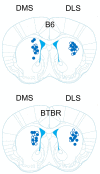The Partial M1 Muscarinic Cholinergic Receptor Agonist, CDD-0102A, Differentially Modulates Glutamate Efflux in Striatal Subregions during Stereotyped Motor Behavior in the BTBR Mouse Model of Autism
- PMID: 37434313
- PMCID: PMC10401636
- DOI: 10.1021/acschemneuro.3c00260
The Partial M1 Muscarinic Cholinergic Receptor Agonist, CDD-0102A, Differentially Modulates Glutamate Efflux in Striatal Subregions during Stereotyped Motor Behavior in the BTBR Mouse Model of Autism
Abstract
The BTBR T+ Itpr3tf/J (BTBR) mouse displays elevated repetitive motor behaviors. Treatment with the partial M1 muscarinic receptor agonist, CDD-0102A, attenuates stereotyped motor behaviors in BTBR mice. The present experiment investigated whether CDD-0102A modifies changes in striatal glutamate concentrations during stereotyped motor behavior in BTBR and B6 mice. Using glutamate biosensors, change in striatal glutamate efflux was measured during bouts of digging and grooming behavior with a 1 s time resolution. Mice displayed both decreases and increases in glutamate efflux during such behaviors. Magnitude of changes in glutamate efflux (decreases and increases) from dorsomedial and dorsolateral striatum were significantly greater in BTBR mice compared to those of B6 mice. In BTBR mice, CDD-0102A (1.2 mg/kg) administered 30 min prior to testing significantly reduced the magnitude change in glutamate decreases and increases from the dorsolateral striatum and decreased grooming behavior. Conversely, CDD-0102A treatment in B6 mice potentiated glutamate decreases and increases in the dorsolateral striatum and elevated grooming behavior. The findings suggest that activation of M1 muscarinic receptors modifies glutamate transmission in the dorsolateral striatum and self-grooming behavior.
Keywords: Striatum; acetylcholine; autism; biosensor; glutamate; muscarinic.
Conflict of interest statement
The authors declare the following competing financial interest(s): Dr. William S. Messer holds patents for the use of muscarinic agonists in the treatment of neurological disorders and is the founder and president of Psyneurgy Pharmaceuticals LLC. Dr. Michael Ragozzino holds a patent for use of muscarinic agonists in the treatment of neurological disorders.
Figures





Similar articles
-
Effects of the Partial M1 Muscarinic Cholinergic Receptor Agonist CDD-0102A on Stereotyped Motor Behaviors and Reversal Learning in the BTBR Mouse Model of Autism.Int J Neuropsychopharmacol. 2022 Jan 12;25(1):64-74. doi: 10.1093/ijnp/pyab079. Int J Neuropsychopharmacol. 2022. PMID: 34791301 Free PMC article.
-
The adenosine A2A receptor agonist, CGS 21680, attenuates a probabilistic reversal learning deficit and elevated grooming behavior in BTBR mice.Autism Res. 2018 Feb;11(2):223-233. doi: 10.1002/aur.1901. Epub 2017 Nov 29. Autism Res. 2018. PMID: 29193861
-
Repetitive self-grooming behavior in the BTBR mouse model of autism is blocked by the mGluR5 antagonist MPEP.Neuropsychopharmacology. 2010 Mar;35(4):976-89. doi: 10.1038/npp.2009.201. Epub 2009 Dec 23. Neuropsychopharmacology. 2010. PMID: 20032969 Free PMC article.
-
Modulation of social deficits and repetitive behaviors in a mouse model of autism: the role of the nicotinic cholinergic system.Psychopharmacology (Berl). 2015 Dec;232(23):4303-16. doi: 10.1007/s00213-015-4058-z. Epub 2015 Sep 4. Psychopharmacology (Berl). 2015. PMID: 26337613
-
5HT2A receptor blockade in dorsomedial striatum reduces repetitive behaviors in BTBR mice.Genes Brain Behav. 2017 Mar;16(3):342-351. doi: 10.1111/gbb.12343. Epub 2016 Oct 21. Genes Brain Behav. 2017. PMID: 27717169 Free PMC article.
Cited by
-
The Overexpression of eIF4E Decreases Oxytocin Levels and Induces Social Cognitive Behavioral Disorders in Mice.eNeuro. 2024 Dec 10;11(12):ENEURO.0387-24.2024. doi: 10.1523/ENEURO.0387-24.2024. Print 2024 Dec. eNeuro. 2024. PMID: 39557567 Free PMC article.
-
Moxie begets MOXI: The journey to a novel hypothesis about Mu-opioid and OXytocin system Interactions.Compr Psychoneuroendocrinol. 2024 Jun 26;19:100244. doi: 10.1016/j.cpnec.2024.100244. eCollection 2024 Aug. Compr Psychoneuroendocrinol. 2024. PMID: 39104824 Free PMC article. Review.
References
-
- Amercian Psychiatric Association . Diagnostic and Statistical Manual of Mental Disorders, 5th ed.; American Psychiatric Publishing, 2013; 10.1176/appi.books.9780890425596. - DOI
-
- Zhou M. S.; Nasir M.; Farhat L. C.; Kook M.; Artukoglu B. B.; Bloch M. H. Meta-analysis: pharmacologic treatment of restricted and repetitive behaviors in autism spectrum disorders. Journal of the American Academy of Child & Adolescent Psychiatry 2021, 60 (1), 35–45. 10.1016/j.jaac.2020.03.007. - DOI - PubMed
Publication types
MeSH terms
Substances
Associated data
Grants and funding
LinkOut - more resources
Full Text Sources
Miscellaneous

